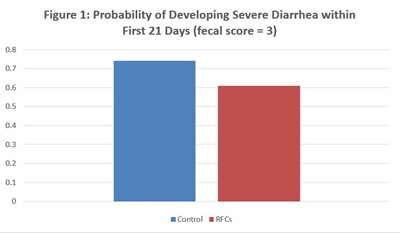
RFCs boost dairy calf health and performance
Raising healthy dairy heifers means optimizing performance and reducing illness and morbidity, especially during the pre-weaning phase. This has always been—and will continue to be—of primary importance for producers and heifer raisers.
Changing regulations and consumer attitudes about on-farm antibiotic usage also mean that farmers are looking for ways to reduce the use of these tools, while still supporting optimal calf health.
A recent trial1 was conducted at two Wisconsin dairy farms to evaluate health and performance of milk-fed commercial Holstein calves supplemented with the Refined Functional Carbohydrates™ (RFC™) in CELMANAX™.
The ABCs of RFCs
RFCs are the components harvested from yeast cells (S. cerevisiae) using specific enzymes during the manufacturing process to ensure a high level of bioavailability. This proprietary enzymatic hydrolysis yields:
- Mannan oligosaccharides (MOS)
- Beta glucans (1,3-1,6)
- D-Mannose
The proprietary enzymatic hydrolysis method of processing used to refine the yeast cells influences the size and structure of these liberated components, which affects bioavailability and functionality. Research2,3,4 shows that each RFC has a specific mode of action and outcome when fed to livestock.
When it comes to heifers, RFCs help provide a healthy foundation for dairy calf and heifer development. RFCs help support the beneficial bacteria of the intestine while blocking sites for attachment by certain pathogens.
Research and Results
During this on-farm study, calves were housed individually indoors for days 1 – 6, then group housed with an automatic feeder until day 56. Three-day-old calves were randomized into treatments with about 80 calves per treatment.
Throughout the trial, calves were monitored for overall health, fecal pathogen shedding and average daily gain (ADG) during the preweaning period.
As dairy farmers know, raising calves is not always a simple, straightforward process due to a variety of factors, as was experienced during the trial. For example, in addition to treatment interactions, interactions were also noted between farm origin, study week, study month and calf passive transfer status.
However, the following overall conclusions were found and bear noting.
First, RFCs numerically reduced predicted probability of severe diarrhea (P=0.15) as shown in Figure 1.

Second, RFCs also reduced the prevalence of Salmonella (P=0.03) and rotavirus (P=0.03), but did not change the prevalence of C. parvum and coronavirus.
Third, RFC-fed calves had numerically higher body weight at 48 days of age compared to control calves. On average, the RFC-calves gained more than 4 pounds vs. calves in the control group.
Ultimately, RFCs improved some gut health parameters, which led to numerical improvement of growth and performance in preweaned dairy calves. Keep in mind, though, it appears that the ability of RFCs to protect young dairy calves from developing severe diarrhea likely depends on factors—such as specific pathogen species and management strategies—found on individual farms.
Citations:
1 Data shown here are part of a larger trial that was presented at the 2017 American Association of Bovine Practitioners Annual Meeting in Omaha, Nebraska, September 14 – 16, 2017.
2 Hashim A, Mulcahy G, Bourke B, Clyne M. Interaction of Cryptosporidium hominis and Cryptosporidium parvum with Primary Human and Bovine Intestinal Cells. Infection and Immunology 2006;74(1):99.
3 Nocek J, Holt MG, Oppy J. Effects of supplementation with yeast culture and enzymatically hydrolyzed yeast on performance of early lactation dairy cattle. J Dairy Sci 2011;94:4046-4056.
4 Baines D, Erb S, Turkington K, Kuldau G, Juba J, Masson L, Mazza A, Roberts R. Mouldy feed, mycotoxins and Shiga toxin - producing Escherichia coli colonization associated with Jejunal Hemorrhage Syndrome in beef cattle. BMC Veterinary Research 2011;7:24.



